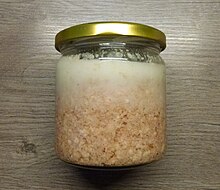This article has multiple issues. Please help improve it or discuss these issues on the talk page. (Learn how and when to remove these messages)
|
Potted meat is a form of traditional food preservation in which hot cooked meat is placed in a pot, tightly packed to exclude air, and then covered with hot fat.[1][2] As the fat cools, it hardens and forms an airtight seal, preventing some spoilage by airborne bacteria.[3] Before the days of refrigeration, potted meat was developed as a way to preserve meat when a freshly slaughtered animal could not be fully eaten immediately.[3][4]

Spores of Clostridium botulinum can survive cooking at 100 °C (212 °F),[5] and, in the anaerobic neutral pH storage environment, result in botulism.
Often when making potted meat, the meat of only one animal was used,[3][2] although other recipes, such as the Flemish potjevleesch, used three or four different meats (animals).
Commercial products
editA potted meat food product is a food preserved by canning and consisting of various seasoned cooked meats, often puréed, minced, or ground, which is heat-processed and sealed into small cans.
Various meats, such as beef, pork, chicken, and turkey, are used. It is produced primarily as a source of affordable meat. Its precooked state and long shelf life make it suitable for emergency food supplies, camping and military uses. Potted meat food product contains high amounts of fat, salt and preservatives which may make it unhealthy for regular consumption. It typically has a soft, spreadable texture, similar to pâté, and is usually eaten in sandwiches or spread on crackers.
Reputation
editCanned potted meats have a somewhat dubious reputation for their taste, texture, ingredients, preparation and nutrition. The canning process produces a product with a generally homogeneous texture and flavor. It utilizes low-cost ingredients such as mechanically separated chicken or turkey, which is disdained in some communities.
Ingredients
edit- Armour Star potted meat contains: Mechanically separated chicken, pork, water, salt, mustard, garlic powder, vinegar, natural flavor, dextrose, sodium erythorbate, and sodium nitrite.
- The Hormel brand contains: Beef tripe, mechanically separated chicken, beef hearts, partially defatted cooked beef fatty tissue, meat broth, vinegar, garlic powder, onion powder, salt, flavoring, sugar, and sodium nitrite.
- Great Value (Walmart) potted meat contains: Mechanically separated chicken, pork, water, salt, mustard, garlic powder, vinegar, dextrose, sodium erythorbate, sodium nitrite, natural flavors, caramel color.
- Libby's potted meat (since discontinued) contained: Mechanically separated chicken, pork skin, partially defatted cooked pork fatty tissue, partially defatted cooked beef fatty tissue, vinegar, salt, spices, sugar, flavorings, sodium erythorbate and sodium nitrite.
See also
editReferences
edit- ^ Briggs, Richard (1788). The English Art of Cookery, According to the Present Practice: Being a Complete Guide to All Housekeepers, on a Plan Entirely New; Consisting of Thirty-eight Chapters. G. G. J. and J. Robinson.
- ^ a b Shephard, Sue (2006-07-03). Pickled, Potted, and Canned: How the Art and Science of Food Preserving Changed the World. Simon and Schuster. ISBN 978-0-7432-5553-0.
- ^ a b c Herbst, Sharon (1995). Food Lover's Companion. new York: Barron's. p. 455. ISBN 0-8120-1520-7.
- ^ Hale, Sarah Josepha Buell (1852). The ladies' new book of cookery: a practical system for private families in town and country; with directions for carving, and arranging the table for parties, etc. Also, preparations of food for invalids and for children (5th ed.). New York: H. Long & brother. OL 6491049M.
- ^ Peleg, M.; Cole, M. B. (2000-02-01). "Estimating the survival of Clostridium botulinum spores during heat treatments". Journal of Food Protection. 63 (2): 190–195. doi:10.4315/0362-028x-63.2.190. ISSN 0362-028X. PMID 10678423.
External links
edit